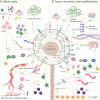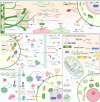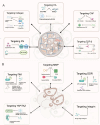Extracellular matrix stiffness: mechanisms in tumor progression and therapeutic potential in cancer
- PMID: 40211368
- PMCID: PMC11984264
- DOI: 10.1186/s40164-025-00647-2
Extracellular matrix stiffness: mechanisms in tumor progression and therapeutic potential in cancer
Abstract
Tumor microenvironment (TME) is a complex ecosystem composed of both cellular and non-cellular components that surround tumor tissue. The extracellular matrix (ECM) is a key component of the TME, performing multiple essential functions by providing mechanical support, shaping the TME, regulating metabolism and signaling, and modulating immune responses, all of which profoundly influence cell behavior. The quantity and cross-linking status of stromal components are primary determinants of tissue stiffness. During tumor development, ECM stiffness not only serves as a barrier to hinder drug delivery but also promotes cancer progression by inducing mechanical stimulation that activates cell membrane receptors and mechanical sensors. Thus, a comprehensive understanding of how ECM stiffness regulates tumor progression is crucial for identifying potential therapeutic targets for cancer. This review examines the effects of ECM stiffness on tumor progression, encompassing proliferation, migration, metastasis, drug resistance, angiogenesis, epithelial-mesenchymal transition (EMT), immune evasion, stemness, metabolic reprogramming, and genomic stability. Finally, we explore therapeutic strategies that target ECM stiffness and their implications for tumor progression.
Keywords: Cancer therapy; Extracellular matrix; Mechanical sensor; Stiffness; Tumor microenvironment.
© 2025. The Author(s).
Conflict of interest statement
Declarations. Ethics approval and consent to participate: Not applicable. Consent for publication: All authors read and approved the final manuscript for publication. Competing interests: The authors declare no competing interests.
Figures





Similar articles
-
Insights into the mechanisms, regulation, and therapeutic implications of extracellular matrix stiffness in cancer.Bioeng Transl Med. 2024 Jul 31;10(1):e10698. doi: 10.1002/btm2.10698. eCollection 2025 Jan. Bioeng Transl Med. 2024. PMID: 39801760 Free PMC article. Review.
-
Targeting extracellular matrix stiffness and mechanotransducers to improve cancer therapy.J Hematol Oncol. 2022 Mar 24;15(1):34. doi: 10.1186/s13045-022-01252-0. J Hematol Oncol. 2022. PMID: 35331296 Free PMC article. Review.
-
Extracellular matrix remodeling in the tumor immunity.Front Immunol. 2024 Jan 25;14:1340634. doi: 10.3389/fimmu.2023.1340634. eCollection 2023. Front Immunol. 2024. PMID: 38332915 Free PMC article. Review.
-
Decoding tumor microenvironment: EMT modulation in breast cancer metastasis and therapeutic resistance, and implications of novel immune checkpoint blockers.Biomed Pharmacother. 2024 Dec;181:117714. doi: 10.1016/j.biopha.2024.117714. Epub 2024 Nov 29. Biomed Pharmacother. 2024. PMID: 39615165 Review.
-
Tumor Microenvironment and Nitric Oxide: Concepts and Mechanisms.Adv Exp Med Biol. 2020;1277:143-158. doi: 10.1007/978-3-030-50224-9_10. Adv Exp Med Biol. 2020. PMID: 33119871
Cited by
-
ECM Mechanics Control Jamming-to-Unjamming Transition of Cancer Cells.Cells. 2025 Jun 20;14(13):943. doi: 10.3390/cells14130943. Cells. 2025. PMID: 40643464 Free PMC article. Review.
-
Translational drugs targeting cancer stem cells in triple-negative breast cancer.Mol Ther Oncol. 2025 Jun 13;33(3):201008. doi: 10.1016/j.omton.2025.201008. eCollection 2025 Sep 18. Mol Ther Oncol. 2025. PMID: 40687439 Free PMC article. Review.
-
Harnessing Organoid Platforms for Nanoparticle Drug Development.Drug Des Devel Ther. 2025 Jul 18;19:6125-6143. doi: 10.2147/DDDT.S530999. eCollection 2025. Drug Des Devel Ther. 2025. PMID: 40698061 Free PMC article. Review.
-
Efferocytosis in tissue engineering: A comprehensive review of emerging therapeutic strategies for enhanced tissue repair and regeneration.Bioact Mater. 2025 Jun 9;52:155-181. doi: 10.1016/j.bioactmat.2025.05.026. eCollection 2025 Oct. Bioact Mater. 2025. PMID: 40585383 Free PMC article. Review.
-
Modeling Tumor Microenvironment Complexity In Vitro: Spheroids as Physiologically Relevant Tumor Models and Strategies for Their Analysis.Cells. 2025 May 17;14(10):732. doi: 10.3390/cells14100732. Cells. 2025. PMID: 40422235 Free PMC article. Review.
References
-
- De Visser KE, Joyce JA. The evolving tumor microenvironment: from cancer initiation to metastatic outgrowth. Cancer Cell. 2023;41:374–403. - PubMed
-
- Yu T-Y, Zhang G, Chai X-X, Ren L, Yin D-C, Zhang C-Y. Recent progress on the effect of extracellular matrix on occurrence and progression of breast cancer. Life Sci. 2023;332: 122084. - PubMed
Publication types
LinkOut - more resources
Full Text Sources

